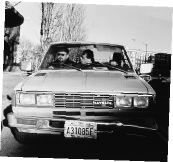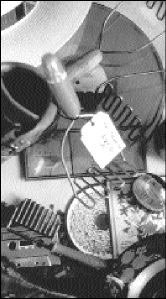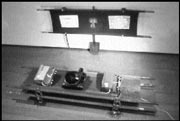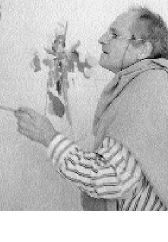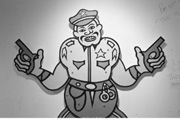THE SURVEILLANCE CAMERA is to the citizen of the workaday world as God is to the converted. We are being watched. While the notion of a benevolent, all-seeing protector is fundamentally reassuring, the reality is a creepy little man in some dark room or, worse, an individual or institution that assumes a godlike power by means of an invisible eye. In our day and age, that person is a rent-a-cop.
the privacy show
SOIL Gallery, 1205 Pike, 264-8061 ends February 25
Conspiracy theories and Big Brother aside, the bottom line is that with hidden cameras we have no choice in losing our privacy. (Nose pickers everywhere, beware.) Mechanical eyes are in most buildings and even on the street (the Seattle Police Department has supposedly installed video cameras at various points downtown to document random crimes). This indiscriminate, pervasive surveillance begs an inevitable set of questions: Where is my image being displayed? Who sees it? Who has access to it? Who owns it?
These are exactly the questions posed—if only rhetorically—by the artists in SOIL Gallery’s “The Privacy Show.” The work displayed seeks to address the issue of privacy and our distinct lack of it in light of ubiquitous video surveillance, burgeoning Internet databases, “real” television, and (for those already in the limelight) the paparazzi.
Paul Davies’ installation is most effective in a crowd. He’s fashioned shoulder slings on which wireless video cameras transmit to tiny monitors on another set of slings. No gallery visitor wearing these devices is safe; one can’t be sure when one’s mug is being recorded or on whose chest that image might be displayed. Vivid photographs by Jeffrey DeGolier similarly catch the general public off guard; an entire wall of “car portraits” of regular folks at the wheel reveals a wide range of reactions to paparazzi-style snaps of private space, from wide grins to angered glares.
Claude Zervas looks at our treatment of monkeys, drawing attention to the fact that the human is the only animal that requires privacy, while we grant no such thing to primates. (I don’t know about you, but when I watch gorillas at the zoo, I feel like I’m staring into someone’s living room.) Unlike catching the odd glimpse of neighbors before their windows, however, this experience is totally devoid of any voyeuristic pleasure. It’s depressing. And in Zervas’ words: “We’ve proven that they are our genetic cousins, yet we’re able to lop off their heads and dissect their brains.” His video of a computer-generated monkey head with frightened, staring eyes depicts a dismantling of its brains, layer by polychromatic layer.
WHETHER WE CHOOSE to or not, it seems inevitable that in our culture we wind up knowing all kinds of intimate details about celebrities’ lives. Dissected like Zervas’ monkey brains are the affairs, bastard children, drug rehabs, and diets of the rich and famous. Samantha Scherer’s drawings poke fun at our insatiable hunger for dirt on these people. She caricatures celebs and politicians—this work is current enough to (regrettably) include Jesse Jackson and the mire of his unfettered loins—on faux tabloid covers.
Rachel Johnston’s video installation of old family movies projected onto a gallery wall through narrow slots gives witness to only abbreviated gestures, motions, and attitudes of the film’s action. In this way, she explains, “the family’s private history remains only pieced together.”
If SOIL’s show runs a little thin, it’s not in the individual pieces or concepts but in its attempt to bite into a mammoth theme that is too ambitious given the artist-run cooperative’s resources. But by playing on all of our inherent paranoias, much of this show succeeds in its insistence on casting our own reflections back at us.
